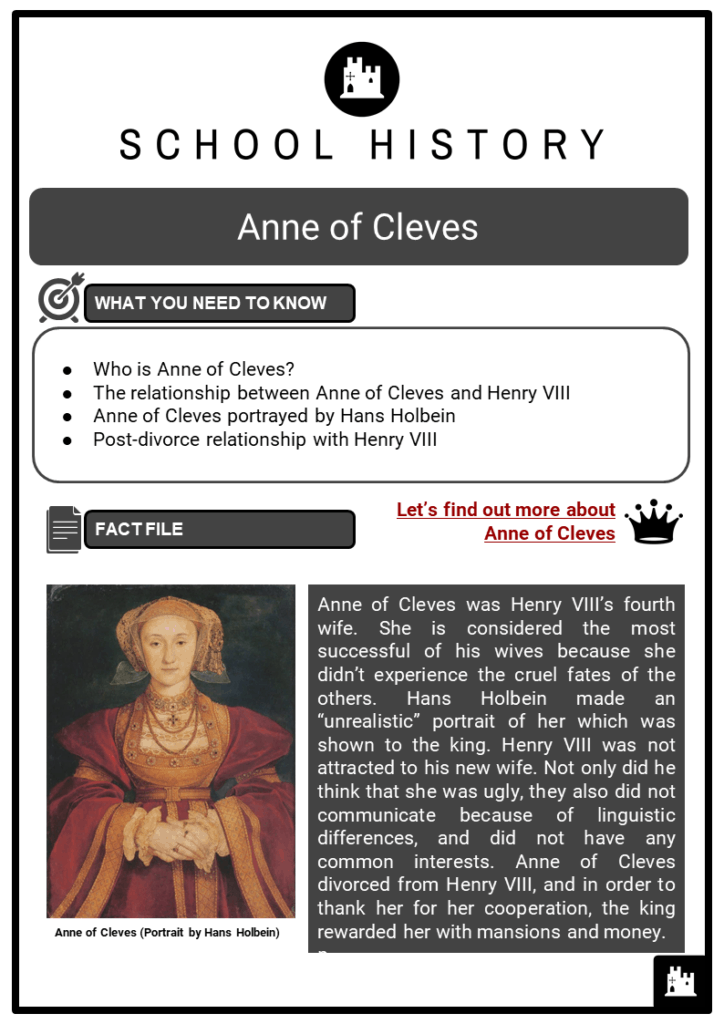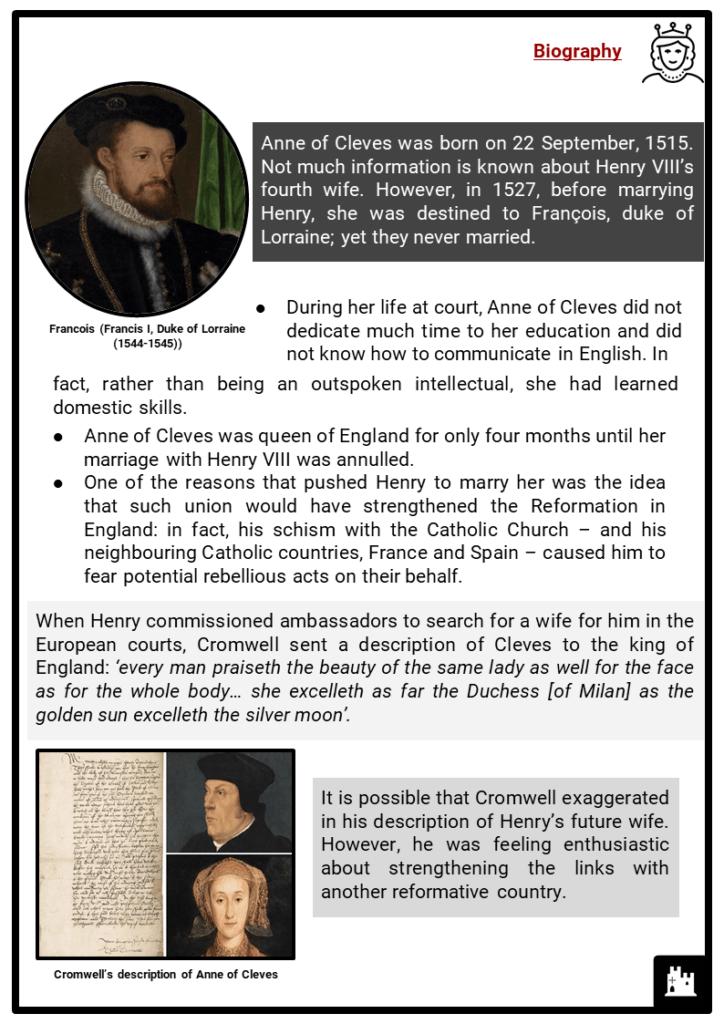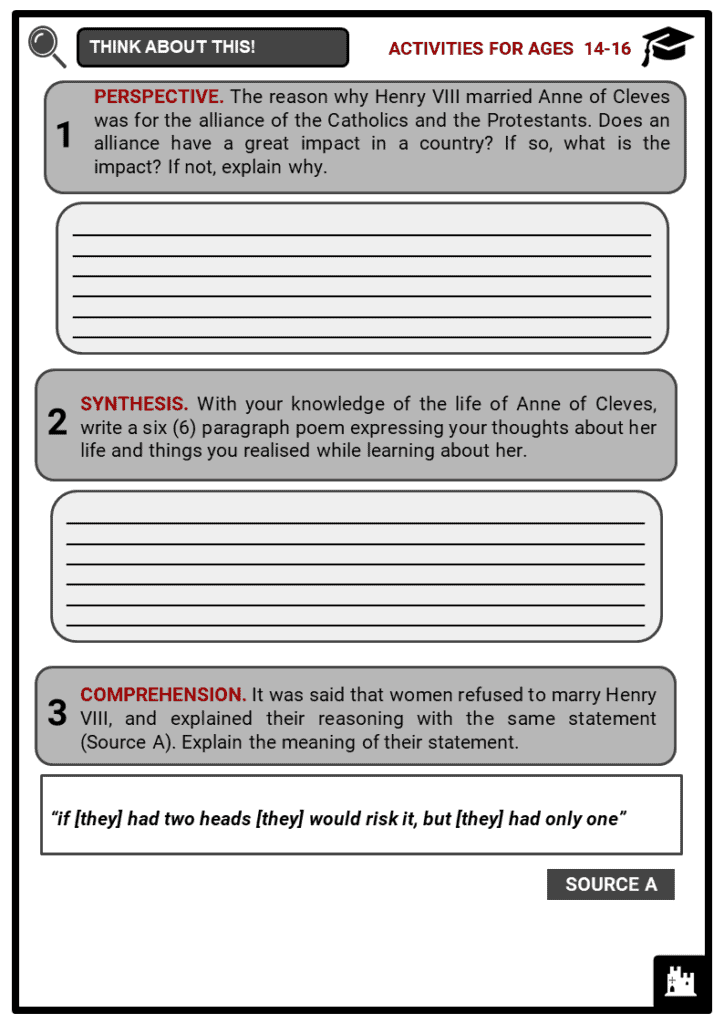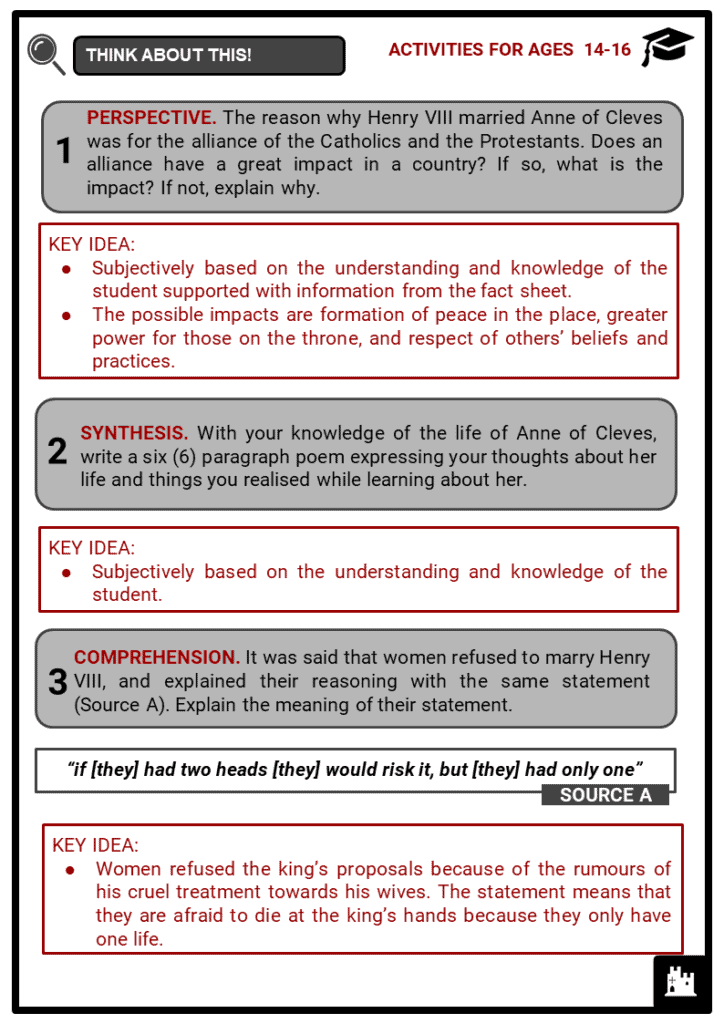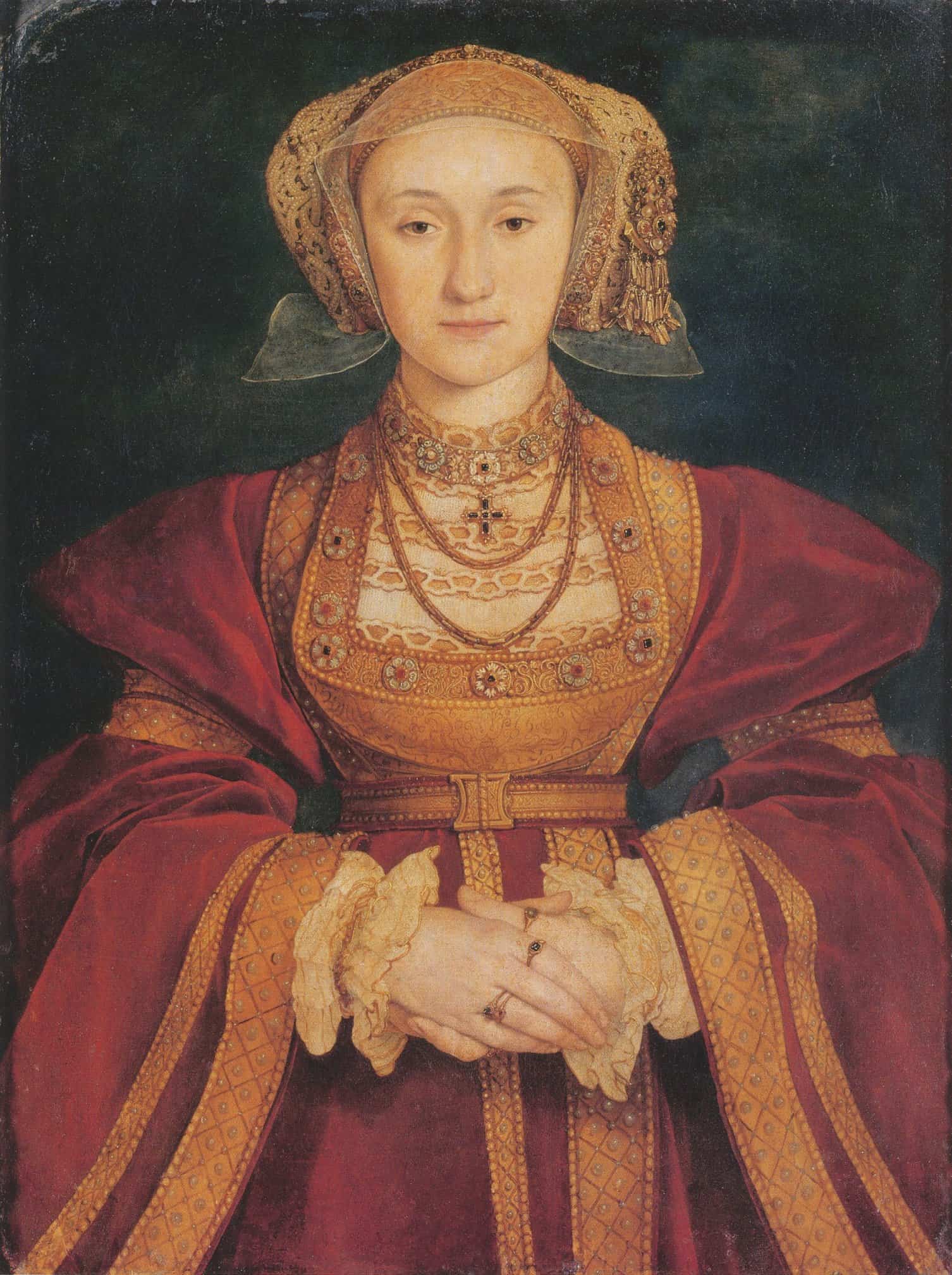Download Anne of Cleves Worksheets
Do you want to save dozens of hours in time? Get your evenings and weekends back? Be able to teach Anne of Cleves to your students?
Our worksheet bundle includes a fact file and printable worksheets and student activities. Perfect for both the classroom and homeschooling!
Table of Contents
Add a header to begin generating the table of contents
Summary
- Who is Anne of Cleves?
- The relationship between Anne of Cleves and Henry VIII
- Anne of Cleves portrayed by Hans Holbein
- Post-divorce relationship with Henry VIII
Key Facts And Information
Let’s find out more about Anne of Cleves
- Anne of Cleves was Henry VIII’s fourth wife. She is considered the most successful of his wives because she didn’t experience the cruel fates of the others. Hans Holbein made an “unrealistic” portrait of her which was shown to the king. Henry VIII was not attracted to his new wife. Not only did he think that she was ugly, they also did not communicate because of linguistic differences, and did not have any common interests. Anne of Cleves divorced from Henry VIII, and in order to thank her for her cooperation, the king rewarded her with mansions and money.
Biography
- Anne of Cleves was born on 22 September, 1515. Not much information is known about Henry VIII’s fourth wife. However, in 1527, before marrying Henry, she was destined to François, duke of Lorraine; yet they never married.
- During her life at court, Anne of Cleves did not dedicate much time to her education and did not know how to communicate in English. In fact, rather than being an outspoken intellectual, she had learned domestic skills.
- Anne of Cleves was queen of England for only four months until her marriage with Henry VIII was annulled.
- One of the reasons that pushed Henry to marry her was the idea that such union would have strengthened the Reformation in England: in fact, his schism with the Catholic Church – and his neighbouring Catholic countries, France and Spain – caused him to fear potential rebellious acts on their behalf.
- When Henry commissioned ambassadors to search for a wife for him in the European courts, Cromwell sent a description of Cleves to the king of England: ‘every man praiseth the beauty of the same lady as well for the face as for the whole body… she excelleth as far the Duchess [of Milan] as the golden sun excelleth the silver moon’.
- It is possible that Cromwell exaggerated in his description of Henry’s future wife. However, he was feeling enthusiastic about strengthening the links with another reformative country.
- When Henry VIII met Lady Anne, he was highly dissatisfied with her looks, and went to the extent of shouting at Cromwell “I like her not! I like her not!”. She was also very different than all the other noble women: not having extensive knowledge and culture, she dedicated herself mostly to needlework.
- The new queen of England was especially naive. On one occasion she worried she might be pregnant, and confided to her attendants.
- When he [Henry] comes to bed he kisses me and taketh me by the hand, and biddeth me, Goodnight, sweetheart: and in the morning kisses me, and biddeth me, Farewell, darling. Is this not enough?
The relationship of Anne of Cleves with Henry VIII
- Noble women in Europe were well aware that the king’s reputation was not good. In fact, people were shocked by the treatment that his wives had received. Listed below are the wives of the king and their fate.
- Catherine of Aragon - Marriage was void which caused England’s split from the Catholic Church
- Anne Boleyn - Executed for adultery
- Jane Seymour - Died nine days after childbirth due to puerperal fever (infection after childbirth)
- Henry VIII – struggling to find a new consort – sent his ambassadors across Europe in order to search for a possible candidate. The majority of women turned down the English king’s offer.
- Christina of Milan (a beautiful Danish princess) and Marie de Guise (who eventually married the king of Scots) declined the offer of marriage by claiming that ‘if [they] had two heads [they] would risk it, but [they] had only one’.
- After all, Christina of Milan was only sixteen, whereas the king of England was ‘three times her age, fat and with a cruel reputation’
- Although Henry VIII had set out to marry a Catholic, his advisor Thomas Cromwell suggested breaking all relations with the papal state by marrying a Protestant woman.
- Previously, Henry had met his wives without the help of his ambassadors, but he now felt that a diplomatic marriage was needed instead.
- In fact, it is worth remembering that in 1534, the Act of Supremacy recognised Henry VIII as the ‘Supreme Head of the Church of England’, placing him in a difficult isolated position between ultra-Catholic France and Spain.
- When it came to physical appearance, Henry VIII had incredibly high standards and possessed clear ideas of how his wife should look: he did not allow his ambassadors to make any official proposals to the ladies unless he had ‘approved their looks’. As a consequence, Henry VIII’s men commissioned portraits and wrote down detailed accounts of the ladies’ looks and style.
- Anne of Cleves was one of the women that initially sparked the king’s interest. Her brother, William, Duke of Cleves, was not a Protestant; however, thanks to his marriage, he was allied with Saxony and the Lutheran princes.
Anne of Cleves portrayed by Hans Holbein
- According to the king, Holbein’s work did not provide a true representation of Anne: he believed that the portrait beautified her rather than pointing out her true traits.
- Henry VIII also revealed to Thomas Cromwell that ‘she was nothing so fair as she had been reported’ (Hanson 2015; citing Henry VIII). In fact, Holbein had represented her as a gracious young woman ‘with fair hair, a doll-like face, delicate eyes, mouth and chin, and a demure, maidenly expression’.
- As a consequence of the king’s dissatisfaction, Holbein was fired and continued working for the English aristocracy until he died of the plague in 1543.
- In 1540, on New Year’s Day, Henry VIII met Anne of Cleves for the first time: after having disguised himself by wearing a cloak, the king reached Rochester and entered Lady Anne’s chamber.
- His future wife was gazing out of the window, and having approached her, ‘he embraced and kissed her’ (Hanson 2015).
- However, Anne did not recognise him: it was only when the king changed into a purple gown that the lady greeted him appropriately.
- On 6 January, 1540, the two officially married. However, Henry declared that he was not able to consummate the marriage since he did not find her attractive. He was repulsed by her, and could not get around fulfilling his marital duties. In fact, when Cromwell asked the king ‘how liked you the Queen?’, he replied ‘I liked her before not well, but now I like her much worse’.
- Moreover, the king told Anthony Denny – one of his confidants – that he found Anne unattractive and repulsive since he described ‘her breasts so slack and other parts of body in such sort’; he also doubted her virginity not only because of her ‘hanging breasts’ but also because of the ‘looseness of her flesh’.
- The king provided more information about her claiming: ‘she is nothing fair, and have very evil smells about her’ and that she was incapable of ‘excit[ing] and provok[ing] any lust’.
- Henry VIII and his new wife had very different tastes and characters. The two could not even communicate properly.
- Considering his unsuccessful suggestion of marrying Lady Anne in order to build a strong relationship with the Protestants, Henry VIII executed Cromwell on 28 July, 1540.
- Moreover, it is rumoured that before he married Lady Anne, he had already met Catherine Howard, whom he was attracted to.
Post-divorce relationship with Henry VIII
- After the two consorts divorced, Henry VIII was incredibly grateful for Anne’s collaboration and decided to reward her by offering her manors, estates and an income of three thousand pounds per year.
- The king also defined her as a ‘good sister’ and guaranteed her ‘precedence over all ladies in England, except the Queen and [his] daughters’.
- Furthermore, thanks to the financial stability that her divorce had brought her, Anne spent much of her money on gambling and beautiful gowns. She was also allowed to visit the king, spend time with his children and was always welcome at his banquets.
- Her separation from the king was relatively easy: Henry sent his ambassadors and an interpreter to her retreat in Rochester with the news that he no longer wanted to continue their marriage.
- Lady Anne accepted the annulment without hesitation: it is not certain whether she agreed so pleasantly and quickly to divorce from Henry VIII because she was afraid of having to endure the same fate as his previous wives, or because she genuinely did not care about her marital life.
- Therefore, the king and Anne of Cleves signed a declaration that claimed that the marriage was invalid and that it had never been consummated. Anne signed the document as ‘daughter of Cleves’ and not ‘Queen of England’.
- Following her divorce, Anne did not return to her homeland: she remained in England and never married again. After all, her former husband was treating her with the utmost respect and granting her many privileges that she was not entitled to in her own country.
- In a letter to her brother, Anne demonstrated her reconnaissance to the king, and valued her independence as a consequence of financial freedom; she wrote: ‘the King’s highness whom I cannot have as a husband is nevertheless a most kind, loving and friendly father and brother’.
- On 15 July, 1557, Anne of Cleves died after a short illness.
Image sources:
[2.] https://upload.wikimedia.org/wikipedia/commons/7/7d/Lucas_Horenbout_-_Henry_VIII_-_WGA11740.jpg

